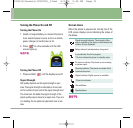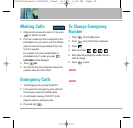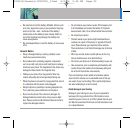
18 Migo
Safety
TIA Safety Information
The following is the complete TIA Safety Information
for wireless handheld phones.
Exposure to Radio Frequency Signal
Your wireless handheld portable phone is a low
power radio transmitter and receiver. When it is ON, it
receives and also sends out Radio Frequency (RF) sig-
nals. In August, 1996, the Federal Communications
Commissions (FCC) adopted RF exposure guidelines
with safety levels for handheld wireless phones.
Those guidelines are consistent with the safety stan-
dards previously set by both U.S. and international
standards bodies:
ANSI C95.1 (1992) *
NCRP Report 86 (1986)
ICNIRP (1996)
American National Standards Institute; National
Council on Radiation Protection and Measurements;
International Commission on Non-Ionizing Radiation
Protection
Those standards were based on comprehensive and
periodic evaluations of the relevant scientific litera-
ture. For example, over 120 scientists, engineers, and
physicians from universities, government health agen-
cies, and industry reviewed the available body of
research to develop the ANSI Standard (C95.1). The
design of your phone complies with the FCC guide-
lines (and those standards).
Antenna Care
Use only the supplied or an approved replacement
antenna. Unauthorized antennas, modifications, or
attachments could damage the phone and may vio-
late FCC regulations.
Phone Operation
NORMAL POSITION: Hold the phone as you would
any other telephone with the antenna pointed up and
over your shoulder.
Tips on Efficient Operation
For your phone to operate most efficiently:
Do not touch the antenna unnecessarily when the
phone is in use. Contact with the antenna affects call
quality and may cause the phone to operate at a high-
er power level than otherwise needed.
Driving
Check the laws and regulations on the use of wireless
phones in the areas where you drive and always obey
1000(E)Parents(120X120)_final 5/2/06 2:49 PM Page 18


















